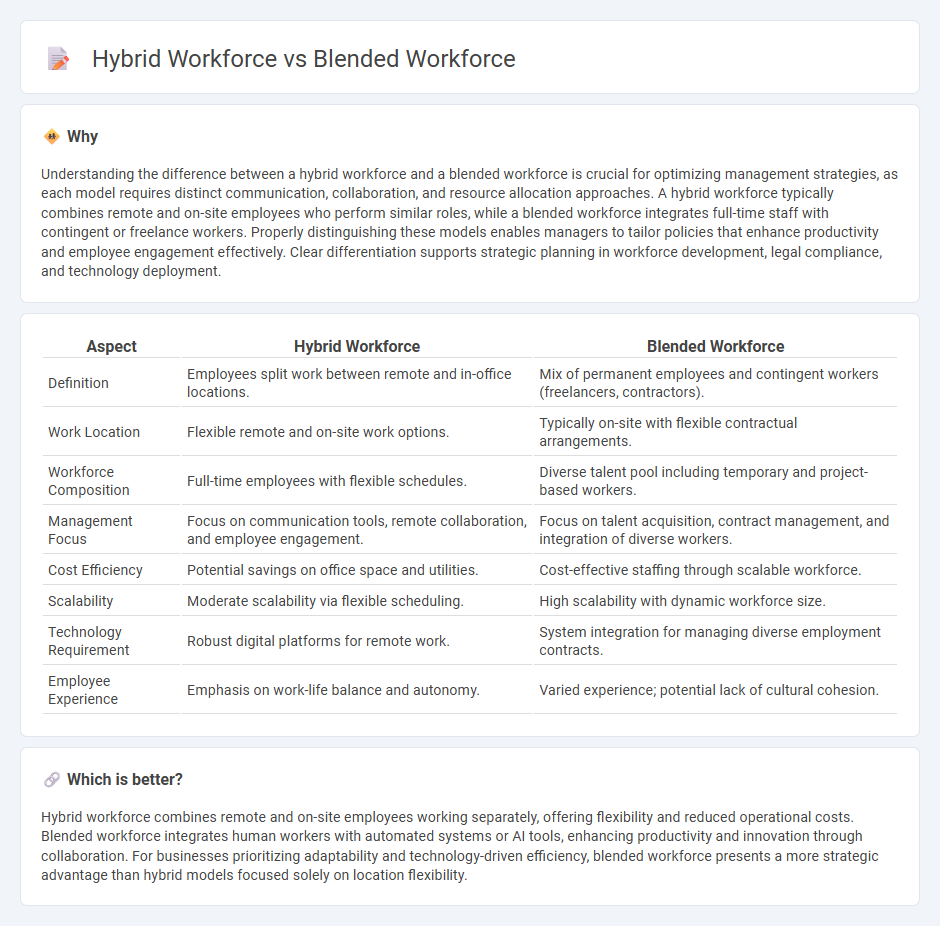
A hybrid workforce combines remote and in-office employees who alternate between locations based on schedule or preference, optimizing flexibility and productivity. In contrast, a blended workforce integrates full-time employees with contingent workers such as freelancers and contractors to enhance agility and access specialized skills. Explore the strategic benefits and challenges of managing hybrid and blended workforces to optimize your organization's performance.
Why it is important
Understanding the difference between a hybrid workforce and a blended workforce is crucial for optimizing management strategies, as each model requires distinct communication, collaboration, and resource allocation approaches. A hybrid workforce typically combines remote and on-site employees who perform similar roles, while a blended workforce integrates full-time staff with contingent or freelance workers. Properly distinguishing these models enables managers to tailor policies that enhance productivity and employee engagement effectively. Clear differentiation supports strategic planning in workforce development, legal compliance, and technology deployment.
Comparison Table
| Aspect | Hybrid Workforce | Blended Workforce |
|---|---|---|
| Definition | Employees split work between remote and in-office locations. | Mix of permanent employees and contingent workers (freelancers, contractors). |
| Work Location | Flexible remote and on-site work options. | Typically on-site with flexible contractual arrangements. |
| Workforce Composition | Full-time employees with flexible schedules. | Diverse talent pool including temporary and project-based workers. |
| Management Focus | Focus on communication tools, remote collaboration, and employee engagement. | Focus on talent acquisition, contract management, and integration of diverse workers. |
| Cost Efficiency | Potential savings on office space and utilities. | Cost-effective staffing through scalable workforce. |
| Scalability | Moderate scalability via flexible scheduling. | High scalability with dynamic workforce size. |
| Technology Requirement | Robust digital platforms for remote work. | System integration for managing diverse employment contracts. |
| Employee Experience | Emphasis on work-life balance and autonomy. | Varied experience; potential lack of cultural cohesion. |
Which is better?
Hybrid workforce combines remote and on-site employees working separately, offering flexibility and reduced operational costs. Blended workforce integrates human workers with automated systems or AI tools, enhancing productivity and innovation through collaboration. For businesses prioritizing adaptability and technology-driven efficiency, blended workforce presents a more strategic advantage than hybrid models focused solely on location flexibility.
Connection
Hybrid workforce and blended workforce both integrate remote and on-site employees to optimize productivity and flexibility. The hybrid workforce specifically refers to a flexible arrangement where employees alternate between working from home and the office, while the blended workforce combines human talent with automation or artificial intelligence to enhance operational efficiency. Effective management strategies must address communication, collaboration, and technology adoption to successfully unify these workforce models.
Key Terms
Employment Model
A blended workforce integrates full-time employees, contractors, and freelancers working in diverse environments, optimizing flexibility and talent acquisition strategies. A hybrid workforce specifically combines remote and on-site employees within a single organization to enhance productivity and work-life balance. Explore further insights on how these employment models impact organizational efficiency and employee engagement.
Work Location
A blended workforce combines full-time employees and contingent workers such as freelancers or contractors, while a hybrid workforce refers to employees splitting their work time between remote and on-site locations. The primary distinction lies in employment type versus work location flexibility, with the hybrid model emphasizing where work is performed. Explore the nuances and benefits of each workforce strategy to optimize your organization's productivity and talent management.
Talent Sourcing
Blended workforce combines permanent employees and outsourced talent to optimize flexibility and cost-efficiency in talent sourcing, enabling businesses to access a broader skill set. Hybrid workforce integrates remote and on-site employees, focusing on location flexibility to attract diverse candidates and improve employee experience. Explore our detailed comparison to understand how each model can transform your talent sourcing strategy.
Source and External Links
Blended Workforce - Awardco - A blended workforce combines full-time, part-time employees, contractors, and freelancers to create a flexible and agile work environment.
What is a Blended Workforce? Keeping Your Business Agile - Mondo - A blended workforce model aids businesses in scaling efficiently by leveraging diverse skills and accessing specialized expertise.
What Is a Blended Workforce? | HR Glossary - AIHR - A blended workforce integrates full-time employees with freelancers, contractors, and part-time workers to achieve flexibility and cost savings.
 dowidth.com
dowidth.com